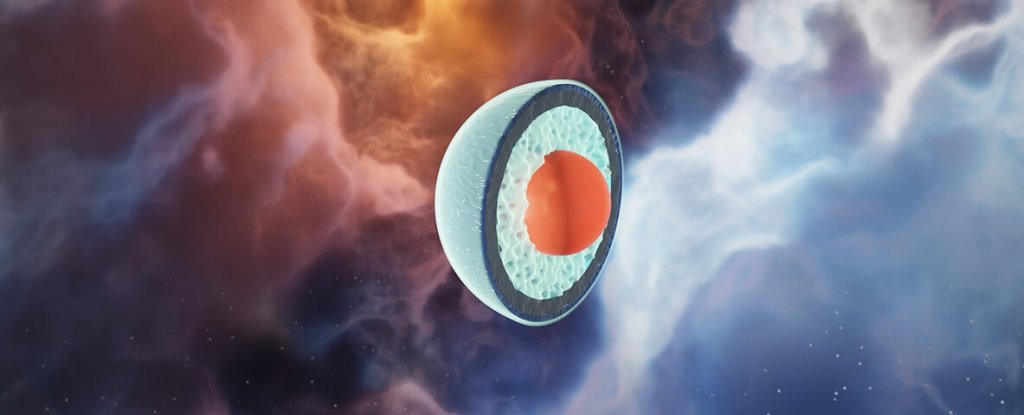
Neutron stars are rising to the top of the list of the most delicious objects in the Universe. First, it was dense "nuclear pasta" beneath their crusts. Now, we have fresh evidence that the cores of the most massive neutron stars are made up of an exotic 'soup' of subatomic particles called quarks.
Physicists have produced new calculations using data from gravitational waves first detected from a neutron star collision in August 2017, along with observations of surprisingly massive neutron stars. Their conclusion hints at an exciting result - the cores of the most massive neutron stars are so dense, atomic nuclei cease to exist, condensing into quark matter.
It is, the researchers say, an important milestone in understanding the strange innards of these extreme objects.
"Confirming the existence of quark cores inside neutron stars has been one of the most important goals of neutron star physics ever since this possibility was first entertained roughly 40 years ago," said theoretical physicist Aleksi Vuorinen of the University of Helsinki and the Helsinki Institute of Physics.
Neutron stars are pretty wild. They're actually dead - the collapsed remnants of massive stars that would have been between 8 and 30 solar masses (a measurement based on the mass of the Sun). When these stars go supernova, most of their mass is blasted off into space; the remaining core collapses down into an incredibly dense object.
The resulting neutron stars can range between about 1.1 and 2.3 solar masses, packed into a dense, small sphere only 10 to 20 kilometres (6.2 to 12.4 miles) across. Five large neutron stars, each containing more mass than our Sun, could comfortably fit along Hadrian's Wall, and with room to spare.
When the core-collapse supernova occurs, the protons and electrons in the atoms that make up the object are compressed into neutrons and neutrinos. The neutrinos escape, leaving the neutrons under such high-pressure conditions that they fuse together, making the neutron star essentially one big nucleus, with a density over 100 trillion times that of water at the base of the crust. (This produces the "nuclear pasta" structures.)
But density is expected to increase the deeper you go, and this is where the idea of quark matter cores comes in. Quarks are fundamental subatomic particles that combine to form composite particles such as protons and neutrons.
You can probably see where this is going. For a few decades, astronomers have hypothesised that, under high-enough heat and density, neutrons break down even further into their constituent quarks, creating a sort of quark soup.
It's really difficult to figure out what's inside a neutron star, though. So the August 2017 collision - GW170817 - was very exciting for astronomers, since the way the two stars changed as they became close enough to gravitationally deform each other could reveal information about their internal structure.
Vuorinen and his team have used that gravitational wave signal along with new theoretical and particle physics results to produce their tantalising calculation. They found that neutron stars towards the upper mass limit of such objects - at least 2 solar masses - show characteristics that indicate the presence of a huge quark matter core, more than half the neutron star's entire diameter.
It's not an absolute slam-dunk; but the calculations indicate that something really peculiar would have to be going on, if the cores of these stars are not quark matter.
"There is still a small but nonzero chance that all neutron stars are composed of nuclear matter alone," Vuorinen explained.
"What we have been able to do however, is quantify what this scenario would require. In short, the behaviour of dense nuclear matter would then need to be truly peculiar. For instance, the speed of sound would need to reach almost that of light."
The discovery of quark matter inside neutron stars wouldn't just be amazing for its own sake - it could help us learn more about the very earliest moments of our Universe.
Cosmologists believe that, for a few microseconds just after the Big Bang known as the quark epoch, the Universe was filled with a hot soup of quark-gluon plasma that rapidly coalesced into hadrons.
These days, we can only find quark matter very briefly in particle collider experiments; but some massive neutron stars could be harbouring it, too. If we can characterise the neutron star conditions under which quark matter forms, that could help us better understand the quark epoch.
Since GW170817, the LIGO-Virgo Collaboration has detected a second neutron star merger, and it's only a matter of time before more start pouring in. Analysis of more mergers could help the team validate their calculations further, and iron out the uncertainties.
"There is reason to believe that the golden age of gravitational wave astrophysics is just beginning, and that we will shortly witness many more leaps like this in our understanding of nature," Vuorinen said.






No comments:
Post a Comment